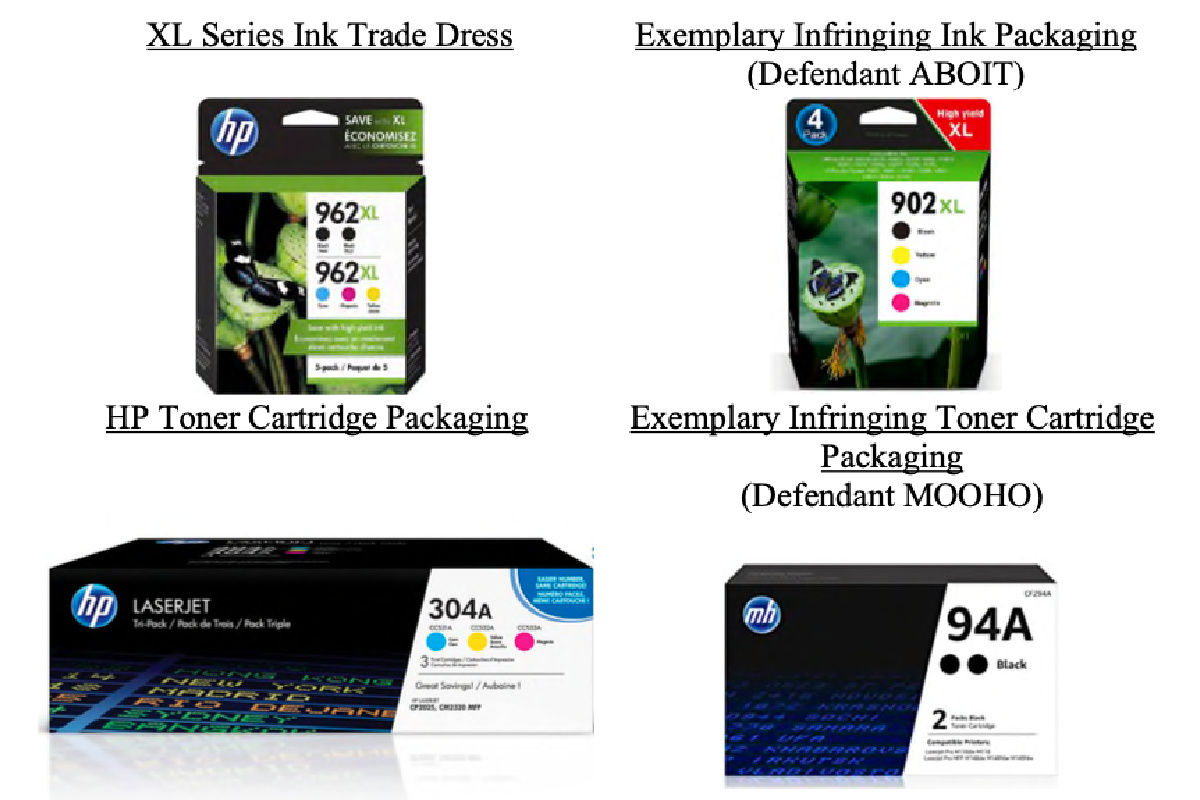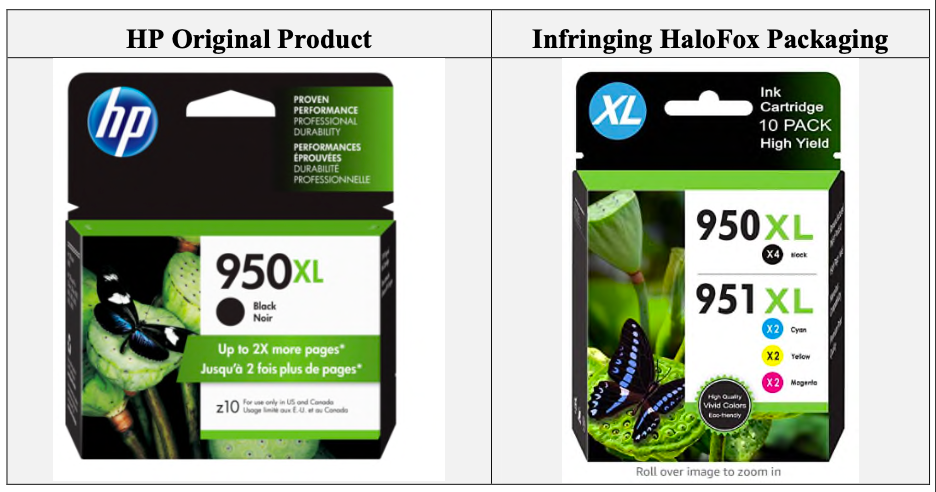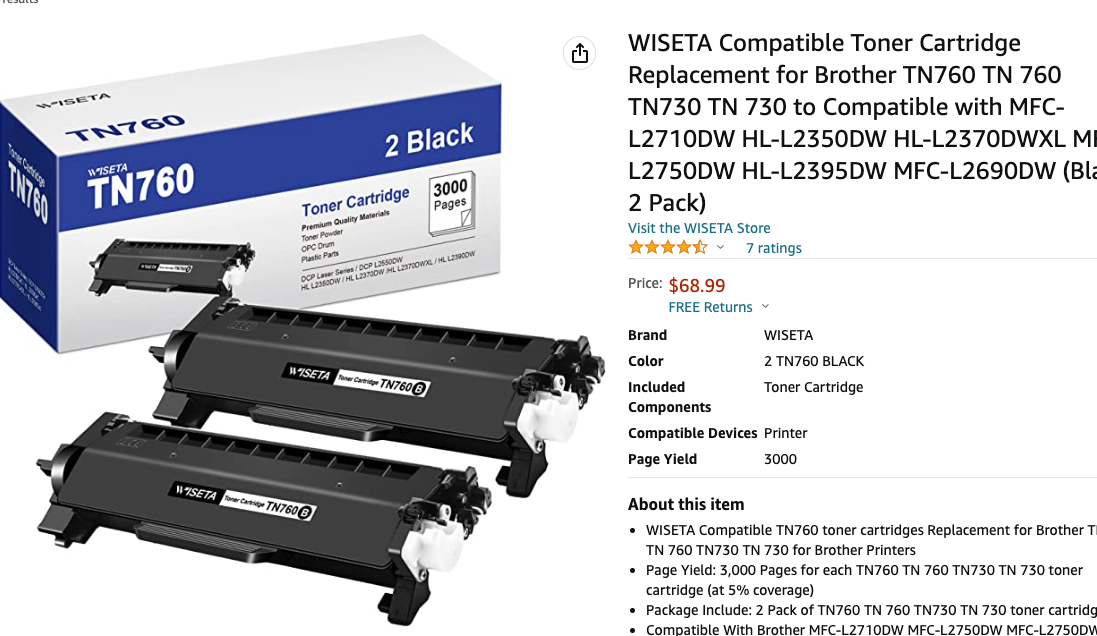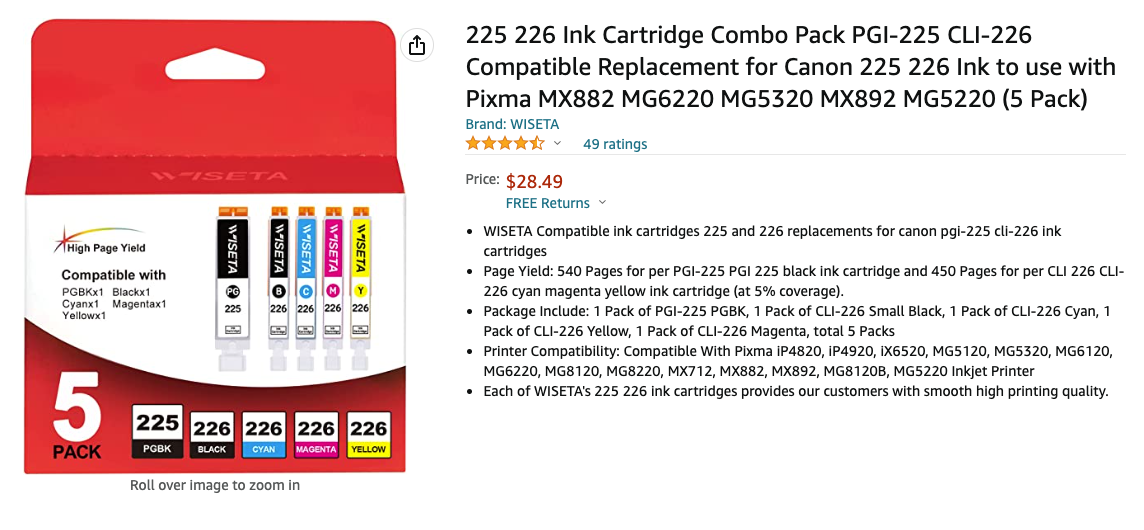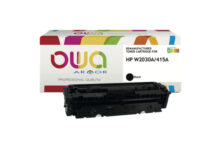It has been several years since we last saw HP sue a third-party cartridge seller in the United States. That changed on January 23.
HP Inc. and Hewlett-Packard Development Company, L.P., have filed a lawsuit against a number of third-party cartridge sellers doing business on online marketplaces like Amazon, Walmart, Newegg, and Temu over their use of trade dress that is deceptively similar to that HP uses on its own ink and toner cartridges. The defendants named in the complaint are WISETA, ZHAICOLOR, MOOHO, ROHON, SHEENGO, ABOIT, HALOFOX, X-E-OFFICE, EJET, KEENKLE, and IDAHOTONER. HP’s claims against the defendants include trade dress infringement, false advertising, unfair competition, and deceptive trade practices.
Copycat Trade Dress
HP Inc. and Hewlett-Packard Development Company, L.P., (collectively HP) filed suit against WISETA, ZHAICOLOR, MOOHO, ROHON, SHEENGO, ABOIT, HALOFOX, X-E-OFFICE, EJET, KEENKLE, and IDAHOTONER on January 23 in the U.S. District Court for the Northern District of California. HP Inc., of course, is the world’s biggest printer maker, and Hewlett-Packard Development Company, L.P., (HPDC) is the actual owner of the trade dress at issue in the complaint. As HP explains, “HPDC licenses its intellectual property, including the trade dress at issue, to its related companies, including HP Inc.”
The defendants aren’t company names but the names of sellers doing business on online marketplaces including Amazon, Walmart, Newegg, and Temu. HP has included an exhibit with a tad more information about the defendants, including other aliases used and some product listings, but the bottom line is that HP says it just doesn’t know much about the true identities of the defendants currently, describing them as “individuals and business entities of unknown makeup.” HP knows where they hail from, however. The printer maker states, “Defendants reside and/or operate in the People’s Republic of China or other foreign jurisdictions with lax trademark enforcement systems or redistribute products from the same or similar sources in those locations.” HP says it will amend the complaint to include “the true names and capacities of defendants” once it discovers them.
The complaint measures a hefty 49 pages, not including exhibits, and it details how the third-party supplies sellers named in the complaint blatantly copy HP’s trade dress and deceive customers. HP opens the complaint with customer reviews complaining that they were taken in by the lookalike packaging:
“I feel SCAMMED!” “100% Misleading,” “Deceptive Packaging NOT HP PRODUCT!” “Don’t be fooled… It is not HP.” “False advertising! The picture on Amazon clearly shows the HP brand ink, but this is NOT from HP.” These are the words of some of the many consumers confused by Defendants—online sellers of off-brand ink and toner who operate behind aliases—into purchasing products made to look like HP Original ink and toner. Defendants’ deception is intentional, perpetrated through blatant copying of HP’s established and well-recognized trade dress for its HP Original ink and toner packaging.
HP’s complaint only uses the word counterfeit once. That is because the lookalikes aren’t exactly counterfeits. If you look carefully at examples shown in the complaint (see above), the knockoffs don’t falsely feature the HP name but instead do show other brands like “4” or “mh” in a similar font as the HP logo. But the intent behind these third-party cartridges would seem to be similar to a counterfeiter’s aim—to make consumers think the cartridges are original HP cartridges. In the United States, trade dress is intellectual property protected under the Lanham Act. It is also the Lanham Act under which we often see OEMs pursue cartridge counterfeiters for trademark infringement.
HP argues its trade dress is distinctive and a key part of the brand identity the company has built over decades:
When consumers see a butterfly amid lush plant life on an ink box, the lime-green and black contrast on an XL cartridge package, and the sleek, sophisticated design of the HP toner packaging with HP’s circular blue logo in the corner, they instantly know the ink and toner comes from HP. The trust, goodwill, and brand identity HP has developed over more than eight decades since its founding in 1939 is wrapped up in the familiar look-and-feel of its HP Original ink and toner packaging.
As noted, the key focus of the complaint is that defendants have decided to copy HP’s trade dress. HP states:
Rather than using their own brand identity or trying to establish goodwill themselves, Defendants decided to copy HP’s trade dress and lure consumers through look-alike digital images of product packaging and/or actual packaging, passing off their products as HP Original ink and toner. Their tactics are working. Defendants are capitalizing on HP’s reputation, creating consumer confusion in the marketplace, and earning ill-gotten profits.
HP’s complaint delves into how HP developed its current trade dress for ink and toner cartridges in 2008 and then launched the packaging in 2009 and 2010. The plaintiff spends pages detailing all the distinctive elements of its trade dress and how this trade dress has “built strong consumer and general public recognition.” HP states:
Customers only need to glance at the packaging design, images, and overall makeup of an ink or toner product to quickly recognize the products as associated with HP. The elements of the HP Trade Dress are so well recognized as an indicator of source for HP at this point, that consumers can identify the origin of the product even without an express reference to “HP.”
HP alleges defendants are taking advantage of this and using digital images on their product packages and designing the actual product packaging itself “to confuse consumers into believing that consumers are purchasing HP Original ink or toner, when they are not.” HP says customers become confused by the similar-looking trade dress, especially when purchasing on sites like Amazon using devices with small screens such as smartphones.
HP goes through each defendants’ products, showing photos of how defendants copy HP’s trade dress and how online reviews from customers taken in by the scheme include complaints such as that “the packaging makes it look as if it is genuine HP ink” and that “though the box looks like HP it’s not.” Some examples of similar trade dress show in HP’s complaint appear below.
HP says that some of the defendants will actually ship the cartridges in packaging that bears no resemblance to the packaging shown online. This, says, HP is a “bait and switch,” with the defendants luring customers with packaging that resembles HP’s shown online.
The lawsuit says:
At least Defendants WISETA, X-E Office, KEENKLE, MOOHO have sold and/or are selling toner cartridges using digital images that infringe on HP’s Toner Trade Dress to induce buyers into purchasing their product, when in fact their actual packaging looks nothing like the product packaging featured in the digital images on their product listing page.
Meanwhile, HP says:
Defendants EJET, WISETA, MOOHO, HALOFOX, ZHAICOLOR, ROHON, ABOIT, and SHEENGO seem to have chosen to copy the HP XL Series Ink Trade Dress because the HP Original XL Series Ink cartridges are more expensive due to HP’s longer lasting and/or higher-yield ink cartridges.
HP alleges that the defendants are engaged in willful deception of consumers. “Each Defendant’s product page conveys the literally false and materially misleading message that the ink or toner they sell is genuine HP Original ink or toner,” argues HP.
By misleading consumers in this fashion, HP says that the defendants are depriving HP and its authorized sellers of sales, unjustly lining their own pocket, and damaging HP’s consumer goodwill.
There are five causes of action or counts in the complaint:
- Trade dress infringement, false designation of origin, unfair competition, and false advertising in violation of the Lanham Act, 15 U.S.C. § 1125.
- Common law trade dress infringement, unfair competition, and misappropriation.
- False advertising in violation of Section 43(a)(1)(B) of the Lanham Act, 15 U.S.C. § 1125(a)(1)(B).
- Unfair competition in violation of California Business & Professions Code §§ 17200 et seq.
- Deceptive trade practices in violation of California Business & Professions Code § 17500 et seq.
In its prayer for relief, HP seeks a preliminary and permanent injunction against the defendants that would enjoin them from copying and infringing HP’s trade dress. HP is also asking for an award of actual damages, punitive and exemplary damages, and disgorgement of defendants’ wrongfully earned profits. HP also wants costs and attorneys’ fees.
Important Lawsuit to Watch
Actionable Intelligence believes this is an important case to watch for a few different reasons.
As noted above, it has been almost a decade since we saw HP file suit against a third-party cartridge vendor in the United States. To the best of our knowledge, the last such complaint was a 2014 patent-infringement lawsuit against Ninestar and its Apex Microelectronics subsidiary (see “HP Sues Ninestar and Apex Micro for Patent Infringement”). That lawsuit ended in a settlement (see “HP Ends Patent-Infringement Complaint against Ninestar and Apex”). Since then, HP has filed patent-infringement lawsuits against third-party supplies vendors in other venues around the world—just not in the United States (see “With Suits in China, Europe, and U.S., HP Pursues Infringers Worldwide,” “HP Asserting Its Inkjet Cartridge Patents in Germany and Poland,” “HP Prevails in Patent Suits in China, Poland, and Spain,” “HP Files Patent-Infringement Suit against Sharing Color in China,” “HP Awarded Favorable Consent Judgment against Sharing Color in China,” and “HP Wins Consent Judgment against Befon in IP Lawsuit in China,” “HP Takes Action to Protect Its Inkjet Patents in Latin America and Korea,” and “More Infringing HP Compatibles Pulled Off the Market—This Time in Latin America”). While it is our understanding that HP works actively behind the scenes to remove products from online marketplaces that infringe its intellectual property (IP), including in the United States, the printer maker has been largely quiet about that activity and has kept it out of U.S. court rooms in recent years. This lawsuit could be a sign that HP is willing to become more aggressive, once again, in turning to the courts to protects its IP in the United States. Thus, that is something we will be watching closely.
This lawsuit, we believe, also represents something new for HP: the first lawsuit that we are aware of over online third-party cartridges sellers infringing HP’s trade dress. It seems possible HP could pursue similar lawsuits over infringing trade dress in other countries as well. After all, online marketplaces and the sellers operating on these sites target customers worldwide.
We are also curious to see any amended versions of the complaint that may identify the companies behind the sellers that offer confusingly similar trade dress. While we must emphasize that we cannot vouch for the veracity of the allegations and the defendants have denied them, ML Products, a third-party cartridge seller that sued Ninestar, Aster, and certain other companies over their practices for selling cartridges on Amazon, alleged in its lawsuit that the HALOFOX brand is controlled by the BillionTree Group and that the EJET brand is owned by Topjet, in which Ninestar owns a majority stake (see “ML Products Sues Ninestar, Aster, BillionTree, Mountain Peak, and V4INK for Unfair Competition on Amazon”).
Finally, we are curious to see if other OEMs take a page from HP’s book and file similar lawsuits alleging infringement of trade dress. After all, these same online sellers aren’t only copying HP’s trade dress but those of other vendors. In just one example, we were able to find WISETA packaging closely resembling that of Brother and Canon in literally seconds on Amazon.
[UPDATE: Due to significant reader interest in this article, we have moved it from our Courthouse Briefings section to Industry Insights so as to be in front of our paywall.]



